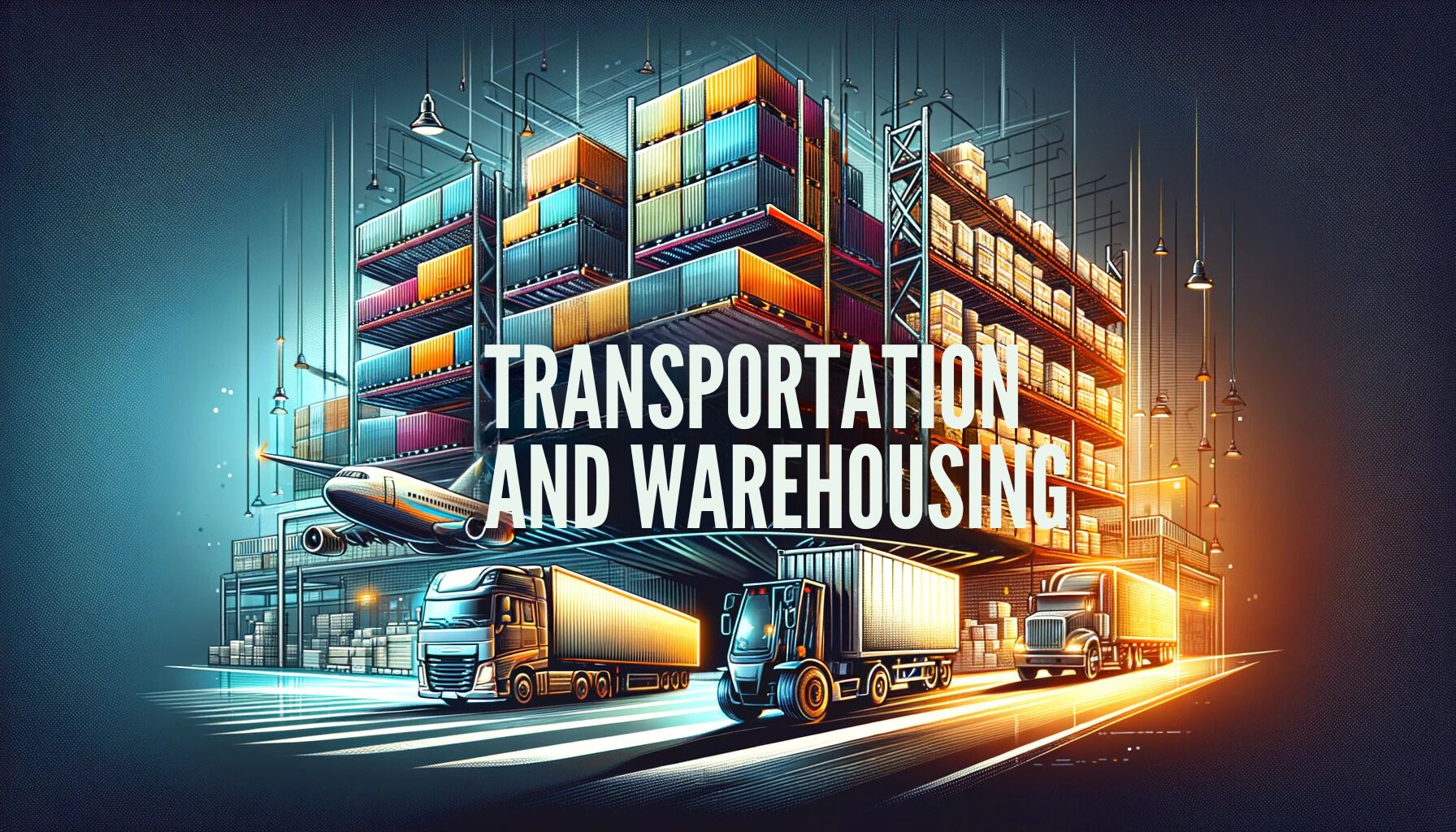Transportation and warehousing are vital pillars of any business’s logistics and supply chain management. Without transportation and warehousing, the movement of goods and their storage would be chaotic, leading to inefficiencies, missed deadlines, and dissatisfied customers. Transportation ensures goods are delivered from one point to another, whether it’s raw materials from suppliers to factories or finished products to customers. Warehousing, on the other hand, provides a secure space to store these goods until they are needed. Together, they optimize the flow of goods, reduce costs, and ensure customer satisfaction in an increasingly competitive market
What is Warehousing?
Warehousing is the process of storing goods systematically in a designated space to ensure their safety, accessibility, and proper management. It acts as a bridge between production and consumption, where products remain until they are ready for delivery. Warehouses are integral to the supply chain because they provide businesses with the flexibility to manage inventory and address supply and demand fluctuations efficiently.
Warehousing involves more than just storage. It is a sophisticated process that includes inventory management, order processing, packaging, and sometimes even light manufacturing or assembly. For instance, e-commerce companies heavily depend on warehouses to organize and dispatch goods quickly to meet customer expectations.
Significance of Warehousing in Business
Warehousing is indispensable for businesses as it allows them to:
- Meet Market Demand: By storing products close to their target market, businesses can respond promptly to customer needs.
- Maintain Consistent Supply: Seasonal businesses, such as agriculture or fashion, benefit from storing surplus inventory during off-seasons.
- Enhance Operational Efficiency: Warehouses act as hubs for inventory management, reducing the risk of stockouts or overstocking.
- Facilitate Better Transportation: Centralized storage points allow businesses to consolidate shipments, leading to cost-effective transportation strategies.
Warehousing also plays a strategic role in safeguarding goods from theft, spoilage, or damage due to environmental conditions. Proper warehousing can directly impact a business’s profitability and reputation by ensuring the availability of high-quality goods.
Types of Warehouse
Businesses use different types of warehouses depending on their specific requirements, the nature of the goods, and operational goals. Each type serves a unique purpose, tailored to business needs.
Private Warehouses
Private warehouses are owned and operated by businesses to store their goods. Large corporations often invest in these facilities to have full control over storage and distribution. For instance, a food manufacturing company might use a private warehouse to store perishable products under controlled conditions.
Private warehouses provide tailored solutions, allowing businesses to maintain inventory control and ensure specific storage conditions. However, these warehouses require significant investment and are generally suitable for companies with consistent storage needs.
Public Warehouses
Public warehouses are commercial facilities available for use by multiple businesses on a rental basis. These warehouses are ideal for smaller businesses or startups that do not require full ownership. They offer flexibility, as businesses can adjust storage space based on fluctuating demands.
Although public warehouses are cost-effective, businesses may face limitations in terms of customization and control.
Automated Warehouses
Automated warehouses integrate advanced technology, such as robotics and artificial intelligence, to manage storage and retrieval operations. These warehouses are highly efficient, minimizing human error and increasing operational speed.
While automated warehouses require a high initial investment, they significantly reduce labor costs and enhance accuracy, making them a valuable asset for large-scale operations.
Cold Storage Warehouses
Cold storage warehouses are designed to store perishable items such as food, medicine, and chemicals. These facilities maintain low temperatures to preserve the quality of goods. Cold storage is critical for industries like agriculture and pharmaceuticals, where product integrity is essential.
Each type of warehouse has its advantages and drawbacks, and businesses often choose based on their specific needs and operational strategies.

What is Transportation?
Transportation involves the physical movement of goods from one location to another using various modes such as road, rail, air, water, or pipelines. It is the backbone of the supply chain, ensuring that goods reach their destinations efficiently and on time. Transportation is not just about moving goods; it’s about ensuring that products are delivered safely, in optimal condition, and within a specified timeframe.
Efficient transportation is a competitive advantage for businesses. It reduces lead times, ensures customer satisfaction, and minimizes costs. For example, a company delivering groceries to households needs reliable transportation to ensure perishable items reach consumers fresh and undamaged.
Role of Transportation in Business
- Global Trade: It enables businesses to expand to international markets by delivering products across borders.
- Economic Growth: It ensures a smooth flow of goods, connecting producers, suppliers, and consumers effectively.
- Operational Efficiency: Reliable transportation minimizes delays, reducing inventory costs and improving supply chain performance.
Without efficient transportation, businesses would struggle to maintain market presence, especially in industries that rely on timely delivery, such as e-commerce and pharmaceuticals.
Modes of Transportation
Choosing the right mode of transportation is crucial for businesses, as it directly impacts delivery time, cost, and product quality. Each mode offers unique benefits depending on the type of goods, distance, and urgency.
Road Transportation
Road transport is one of the most flexible and commonly used modes, especially for short and medium distances. Businesses use trucks, vans, and trailers to transport goods directly from warehouses to retail stores or customers.
Road transportation allows door-to-door delivery and is suitable for various goods, from small parcels to heavy machinery. However, it is subject to traffic congestion and environmental concerns, which may affect efficiency.
Rail Transportation
Rail transport is ideal for bulk goods over long distances. It is cost-effective, environmentally friendly, and suitable for commodities like coal, steel, and agricultural products. However, it lacks the flexibility of road transport and requires additional logistics for last-mile delivery.
Air Transportation
Air transport is the fastest mode of transportation, making it suitable for high-value or time-sensitive goods like electronics, pharmaceuticals, and perishable items. Although air transport is expensive, it offers unparalleled speed and reliability for international shipments.
Water Transportation
Water transport is economical for moving large quantities of goods over long distances, especially in international trade. Ships and barges carry heavy goods like oil, machinery, and agricultural products. However, water transport is slower and weather-dependent, requiring businesses to plan carefully.
Pipeline Transportation
Pipeline transport is specialized for liquids and gases, such as oil, natural gas, and chemicals. It offers continuous and reliable flow but is limited to specific types of goods.
Each mode has its strengths and limitations, and businesses often use multimodal transportation to optimize efficiency.
Role of Transportation and Warehousing in Business
Transportation and warehousing work together to form the backbone of logistics. Their combined role is pivotal in ensuring businesses remain competitive and efficient in a fast-paced market.
Streamlining Supply Chain Operations
Transportation ensures goods are moved efficiently between various points in the supply chain, while warehousing provides a central location to store and manage inventory. Together, they reduce lead times and ensure a smooth flow of goods, from suppliers to end-users.
Reducing Costs
Warehousing allows businesses to consolidate shipments, reducing the frequency and cost of transportation. Similarly, efficient transportation routes and modes minimize expenses, ensuring profitability. For example, a company storing inventory in a central warehouse can combine multiple small shipments into one, saving transportation costs.
Ensuring Customer Satisfaction
Customers today demand quick, reliable deliveries. Warehousing ensures products are always available, while transportation ensures timely delivery. This synergy enhances customer trust and loyalty.
Supporting Market Expansion
Efficient transportation and warehousing enable businesses to enter new markets by maintaining a reliable supply chain. For instance, global e-commerce companies rely on strategically located warehouses and fast transportation to serve customers worldwide.
Mitigating Risks
Warehousing safeguards goods from theft, spoilage, or damage. Transportation minimizes risks during transit by using reliable vehicles and technology to track shipments. Together, they ensure products reach customers in the best condition.
Transportation and warehousing are not just logistical necessities; they are strategic assets that drive growth, efficiency, and customer satisfaction.
Transportation and Warehousing FAQs
Why are transportation and warehousing crucial for businesses?
Transportation and warehousing ensure goods are stored securely and delivered efficiently, reducing costs and improving customer satisfaction.
What types of businesses benefit most from warehousing?
Industries like e-commerce, manufacturing, retail, and pharmaceuticals rely heavily on warehousing for efficient inventory management and timely delivery.
How do businesses choose the best mode of transportation?
Businesses consider cost, speed, distance, and the nature of goods. For example, air transport is suitable for urgent deliveries, while rail transport is economical for bulk goods.
What are the advantages of automated warehouses?
Automated warehouses improve efficiency, accuracy, and speed, reducing labor costs and minimizing errors in inventory management.
Can transportation and warehousing reduce operational risks?
Yes, they minimize risks by safeguarding goods during storage and ensuring reliable transit, reducing delays and losses.


